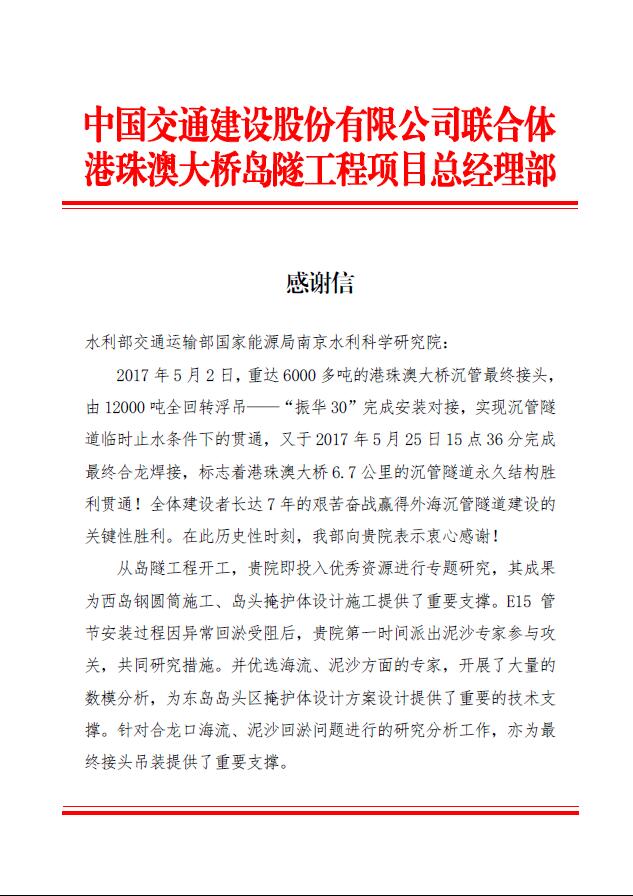

At 15:36, May 25, 2017, last immersed tunnel element was successfully placed and welded, marking the successful connection of the tunnel, a permanent control structure for HongKong-Zhuhai-Macao Bridge. Project Management Department for Island & Tunnel Project of HongKong-Zhuhai-Macao Bridge sent a Letter of Thanks to NHRI for its key technical support.
As early as engineering feasibility study stage during 2004-2007, NHRI conducted the analysis of seabed evolution of proposed bridge area, discussed the natural environment features, overall dynamic framework, water-sand movement characteristics and their interactions of the Lingdingyang Bay, systematically summarized the seedbed siltation rules of the bridge zone, and proposed the bridge site from the perspectives of navigability and swale stability, providing the basis for project preliminary design bidding. In that period, NHRI finished special topic studies, such as calculations of design hydrological elements of wave, tide, current and level of waters adjacent to the bridge, and water-sand numerical simulation for bridge location schemes, etc., gave multi-scheme comparison opinions on the locations and shapes of bridge, tunnel and artificial islands in the navigation area of the bridge. On the basis of bridge northward movement of the north line, reasonable layout of frontier inspection stations at the artificial islands and adoption of wide distance between the artificial islands were proposed after study.
During the stage of in-depth feasibility study and preliminary design of the bridge in 2008-2010, NHRI research team carried out the comparison tests and analytic demonstration of the bridge layout and foundation trench stability by multiple research means, such as 2D and 3D tide-current-sediment numerical modeling, physical modeling of large-scale hydrodynamic sediment, series model tests of local scouring in wide flume, in-situ experiments, etc., which made the design scheme more reasonable at that stage. Taking the scheme optimization of bridge, tunnel and artificial islands as example, artificial islands were adjusted from original strip to an elliptical shape and eventually optimized for a goose egg shape, and the width of upstream face was shortened from the original 1000m to 625m. The research findings provided key technical support for the state approval of engineering feasibility study report and review of the main project construction plan by the Ministry of Transport. The study Impacts of HongKong-Zhuhai-Macao Bridge on Water-Sand Environment, Harbors and Navigation Channels in the Lingdingyang Bay, led by NHRI, won the First Prize of 2016 China Water Transport Science and Technology Award.
Since the construction of artificial islands and tunnel in 2010, NHRI has continued its input of best resources in the studies of technical problems encountered in the process of construction, and the findings have provided significant technical support to islands construction of steel cylinder, and design and construction of covering bodies of islands heads. When the placement of No. E15 immersed tunnel element was hampered due to abnormal back siltation in 2014, NHRI sent its experts immediately to study the countermeasures, and a complete system of back siltation prediction and early warning was established to guarantee the smooth placement of E15 and its successive 18 immersed tunnel elements. In view of the complicated water-sand issues encountered in the process of placing the immersed tunnel elements at the connection part between east artificial island and tunnel, NHRI experts of ocean current and sediment study conducted a large amount of numerical modelling, providing a key basis for the design of cover body plan for east island head. Meanwhile, special researches were carried out for ocean current and back siltation at the closure gap of tunnel, providing important support for smooth hoisting of the final connection element.
HongKong-Zhuhai-Macao Bridge is a major project connecting Lantau Island in HongKong, Macau Peninsula and Zhuhai in Guangdong Province, with a total length of 49.968km. The main works (bridge and tunnel in sea) length is 35.578km, among which the undersea tunnel is about 6.75km long, and the sea bridge about 29km long.

